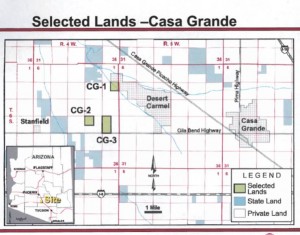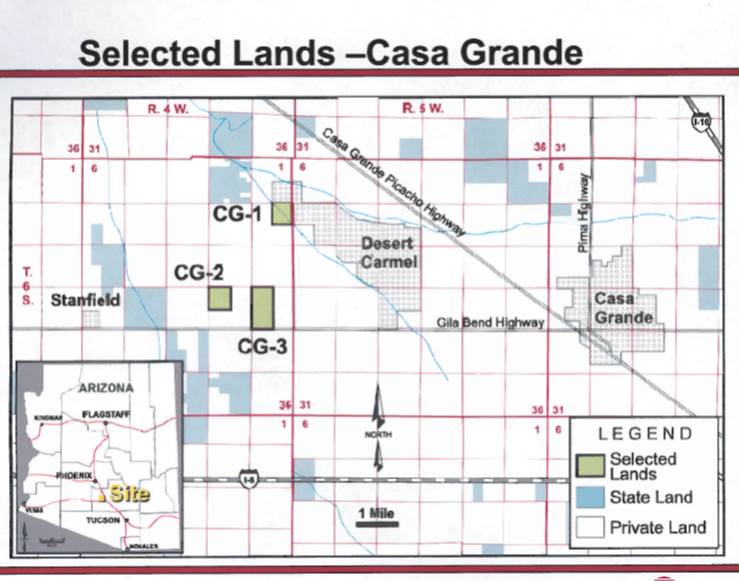 From the Bureau of Land Management Ray Land Exchange SEIS FAQs. Read the full article here. From the Bureau of Land Management Ray Land Exchange SEIS FAQs. Read the full article here.For more information on the Ray Land Exchange click here.
For maps of the Selected Lands click here.
What is the Ray Land Exchange proposal?
The Ray Land Exchange began in 1994 with a proposal from ASARCO LLC (Asarco) to acquire Bureau of Land Management (BLM) lands near or adjacent to their Ray Mine operations and in the Casa Grande vicinity, in exchange for private parcels Asarco owns which have been identified by the BLM as desirable for public ownership. Asarco would acquire approximately 8,196 acres of public lands (where both the surface and mineral estate are administered by the BLM) and approximately 2,143 acres of mineral estate lands (where the surface estate is owned by Asarco and the mineral estate is administered by the BLM). Asarco also identified approximately 637 acres of BLM mineral estate lands near Casa Grande, Arizona, where Asarco owned the surface estate. All of these lands, referred to as the Selected Lands, total approximately 10,976 acres. |
Ray Land Exchange Selected Lands
|
Ray Mine Parcels
|
|
|
Copper Butte Parcels
|
|
|
Chilito Parcels
|
|
|
Casa Grande Parcels
|
|
In exchange for the Selected Lands, Asarco has offered 7,304 acres of private land that they own that the BLM has identified as desirable for public ownership and management. These “Offered Lands” possess resource qualities considered to be of significant value to the public and have been identified for acquisition by the BLM. The highly valuable resource lands include parcels within or adjacent to wilderness areas and Areas of Critical Environmental Concern (ACEC), lands containing riparian areas, and lands that serve as habitat for endangered species and other special category wildlife species, such as the desert tortoise.
Ray Land Exchange Offered Lands
|
Gila River at Cochran Parcel
|
|
|
Knisely Ranch Parcels
|
|
|
McCracken Mountain Parcels
|
|
|
Sacramento Valley Parcel
|
|
|
Tomlin Parcels
|
|
Why is the BLM doing a Supplemental Environmental Impact Statement (SEIS)?
The Tucson Field Office of the Bureau of Land Management (BLM) is beginning to prepare a Supplemental Environmental Impact Statement (SEIS) for the Ray Land Exchange. The SEIS will supplement the Final Environmental Impact Statement (FEIS) issued in 1999 and the Record of Decision (ROD) issued on April 27, 2000. The decision approved a land exchange between Asarco and the BLM for approximately 10,976 acres of Selected Lands identified for acquisition by Asarco in exchange for approximately 7,304 acres of Offered Lands to be acquired by BLM.
The FEIS and ROD were challenged by three environmental groups, the Center for Biological Diversity, the Western Land Exchange Project, and the Sierra Club (collectively called CBD) administratively and in federal court, ultimately prevailing in the Ninth Circuit Court of Appeals in November, 2010. The Ninth Circuit concluded that the BLM violated the National Environmental Policy Act (NEPA) and the Federal Lands Policy and Management Act (FLPMA) “in assuming without explanation that Asarco would perform mining operations on the selected lands in the same manner regardless of the land exchange.” The court recognized that Asarco has the right to conduct mining and related activities under the General Mining Law, based on Asarco’s mining and mill site claims on the Selected Lands. But the court believed that the manner and extent of mining was likely to differ depending on whether the Selected Lands are owned by the United States as public lands subject to the BLM’s surface use regulations at 43 CFR Subpart 3809 or by Asarco as private lands in fee simple, in which case the BLM’s surface use regulations would not apply.
Because the deficiencies in the 1999 FEIS are narrow in scope the BLM has determined that conducting the analysis using the Supplemental EIS guidelines is the appropriate tool.
What will be included in the SEIS?
The SEIS will supplement the 1999 FEIS by providing a “with and without” comparative analysis found lacking by the Ninth Circuit. This analysis will compare two scenarios of potential environmental impacts on the Selected Lands from mining operations. One scenario analyzes potential impacts that could occur as a result of mining activities on the Selected Lands if they are not exchanged and remain under BLM jurisdiction (i.e., mining occurs with BLM regulations). The other scenario analyzes potential impacts that could occur as a result of mining activities if the Selected Landsare exchanged and become privately owned lands (i.e., mining occurs without BLM regulations).
The SEIS will also address any substantial changes in the land exchange and any significant new circumstances or information that are relevant to analyzing the impacts of the land exchange (see 40 C.F.R. § 1502.9(c); BLM NEPA Handbook § 5.3).
What is the process to complete the SEIS?
The process to complete the SEIS is as follows:
- Prepare a Draft SEIS — Resource specialists within the BLM are currently conducting applicable resource analyses and writing the Draft SEIS materials.
- Publish Draft SEIS/Public Comment Period – Upon completion of document preparation the Draft SEIS will be published and presented to the public for a 45-day review and comment period. Public meetings will be held to present the Draft SEIS to the public and receive comments on the draft document.
- Prepare Final SEIS and respond to public comments – The BLM will analyze all public comments and substantive comments will be used to revise the Draft SEIS.
- Publish Final SEIS/Public Availability Period – The revised Draft SEIS will be published as the Final SEIS. Publication is followed by a 30-day Public Availability Period. While the availability period is not a formal public comment period, the BLM may receive comments on the Final SEIS which may be addressed in the Record of Decision.
- Record of Decision (ROD) – The ROD is the final step in the SEIS process. The ROD is a document that states what the decision is and discusses all the factors that were contemplated in reaching a decision.
The schedule to complete the SEIS is as follows:
- Summer/Fall 2012 – Conduct resource analyses and write supplemental materials
- Fall 2012 – Publish Draft SEIS, initiate 45-day public comment period and hold public comment meetings
- Winter 2012/2013 – Revise SEIS based on public comment
- Spring 2013 – Publish Final SEIS
- Spring 2013 –Publish Record of Decision












